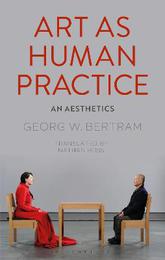
|
Art as Human Practice: An Aesthetics
Paperback / softback
Main Details
| Title |
Art as Human Practice: An Aesthetics
|
| Authors and Contributors |
By (author) Georg W. Bertram
|
|
Translated by Nathan Ross
|
| Physical Properties |
| Format:Paperback / softback | | Pages:256 | | Dimensions(mm): Height 216,Width 138 |
|
| Category/Genre | Theory of art
Philosophy - aesthetics
Social and political philosophy |
|---|
| ISBN/Barcode |
9781350063150
|
| Classifications | Dewey:111.85 |
|---|
| Audience | | Tertiary Education (US: College) | |
|---|
|
Publishing Details |
| Publisher |
Bloomsbury Publishing PLC
|
| Imprint |
Bloomsbury Academic
|
| Publication Date |
10 January 2019 |
| Publication Country |
United Kingdom
|
Description
How is art both distinct and different from the rest of human life, while also mattering in and for it? This central yet overlooked question in contemporary philosophy of art is at the heart of Georg Bertram's new aesthetic. Drawing on the resources of diverse philosophical traditions - analytic philosophy, French philosophy, and German post-Kantian philosophy - his book offers a systematic account of art as a human practice. One that remains connected to the whole of life.
Author Biography
Georg W. Bertram is Professor of Philosophy and Aesthetics at the Freie Universitat Berlin, Germany. Nathan Ross is Associate Professor of Philosophy at Oklahoma State University, USA.
Reviews[This] book builds an important bridge between contemporary Continental and Anglo-American philosophy of art, as Bertram rather seamlessly discusses figures who rarely meet under the same cover ... [It] should provoke thoughtful discussion on whether and/or to what extent art should be viewed in a less object-centered manner, as a reflective practice. * Notre Dame Philosophical Reviews * In his groundbreaking new book, Georg Bertram argues that human beings turn to artistic meaning-making precisely when they are foundering in practice or confused about how to find coherence and value in their practical lives--a recurring phenomenon within the disruptions of modernity. Audiences of artworks in turn participate imaginatively in the work's sensuous-formal exploration of new possibilities of sense. In this way, Bertram shows how art is neither a matter of entertainment alone nor theoretical insight alone, but instead urgently and intimately part of the ongoing, reciprocal self-constitution of subjects as bearers of stances within and on practices. There is no better account than this of how and why art matters. -- Richard Eldridge, Charles and Harriett Cox McDowell Professor of Philosophy, Swarthmore College, USA
|